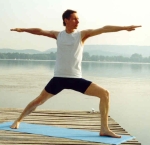1
Equilibrium: Improve Your Dancing With Yoga.
Guest Writer: Lubosch Bublák Editing And Translation: Kerstin Lange Photography: Helmut Römhild
Ashtanga-Yoga (Poweryoga) and the dancer’s technical training perfectly complement each other. This kind of yoga
provides physical and mental training and usually leads to better results in competition.
So don’t think that Ashtanga-Yoga has something to do with relaxing and meditating on a soft blanket – on the contrary.
and can bring you close to your maximum heart rate.
It is an old traditional school of yoga, characterised by activity, joining the individual yoga postures to form a
continuous flow of movement.
Powerful breathing provides the focus and leads from one posture to the next giving the body a workout,
improving strenght, flexibility and endurance.
And there is more: In addition to training the physical abilities the mental power is enhanced.
This is the reason why Ashtanga-Yoga is considered one of the most efficient types of yoga, highly popular,
celebrities like Madonna, Sting, and Gwyneth Paltrow leading the trend.

Guest Writer:
Lubosch Bublák
Yoga teacher, former competition dancer,
BDY, VYLK, TaMeD e.V.
www.ashtanga-yoga-kiel.de
Balancing Jelly: The Physical Part.
To move across the floor in a flowing motion is the result of a firmly controlled body.
Ashtanga-Yoga training results in powerful but still extremely flexible muscles.
Ashtanga-Yoga also helps against the effects of the one-dimensional character of competition sports.
For instance yoga exercises help to improve the lady’s posture for ballroom dancing.
Yoga leads to a better understanding of the needs of the body: An invaluable help to identify and
close gaps in training.
Lubosch Bublák in Hamburg
Learn about Ashtanga-Yoga basics
and visit the Mental Power Training of Christine und Thomas Heitmann,
March 19 to March 20.
Information/Register:
christineheitmann@gmx.de
thomasheitmann@gmx.de
‘Electrical Feet’: The Mental Part.
Dancesport is becoming more and more demanding.
Choreographies and combinations of steps in dancing are highly creative, more and more filled with action,
more and more difficult.
Consequently ‘Tempo’ was the main topic of the latest judges’ training in Bad Kissingen.
But how can a dancer follow Asis and perform with ‘Electrical Feet’?
The answer is: mental power. And like physical strenght also mental power can be acchieved and enhanced by training.
Ashtanga-Yoga provides the means, mainly by focussing on the respiration, on controlled and powerful inhaling and exhaling and retention of breath.
On the dancing floor focussing on respiration helps to concentrate, to ignore distractions,
to be aware of the present task, of what has to be done during the short time a dancer has to perform on the floor.
Nothing Easier Than That ...
Everybody is enthusiastic: The commentator, the audience and myself.
I am a fresh C-level competition dancer, from my point of view nothing is easier than that:
show a little sway and that's it.
I still remember the Heitmann’s performance – also my futile attempts on imitating their smooth flow of steps.
And despite analysing it in slowest slow motion –
I either slipped, kicked, or, spinning, lost balance and timing, no longer able to follow the music
.
Several years (without any dancing) later: I am working on the Viennese Waltz again, having the privilege of a private lesson by Christine Heitmann.
But – what’s happening here?
My feet are moving in time, I can follow the music, no slipping, no kicking, my body has a center of stability ...
Then I realised: I had turned the years without dancing into an advantage by regularly exercising yoga.
Training cancelled?
and let your muscles stay flexible, keep your fitness, and even enhance your agility and your mind’s capacity for concentration.
Gaining mental power and using it to relax and calm body and mind, a competition dancer can unleash all his skills
and achieve better results in tournaments.
Competition dancers of Hamburg’s Club “Céronne” were able to make this experience.
Warming up before starting in a tournament is a must – but how to do it efficiently?
We see “Speedy Gonzales” racing across the dancing floor, “Fred The Frog” jumping up and down until muscles turn to stone,
we see dancers doing the splits, ligaments and muscle fibres passively extended by gravity.
Ashtanga-Yoga is a much better way.
The muscles are activated by energetic postures, they become flexible and make it easy to glide into the first step of the Slow Waltz.
Integrated Training.
Jason Beechey, Director of Dresden’s ‘Palucca Hochschule für Tanz’, a former ballet dancer, confirmed: Ashtanga-Yoga can help to learn about limitations and to handle them.
Yoga – he said in an interview – is “the intelligent way”.
Because “a dancer wants to improve his or her strength,
and this is the reason why many do jogging or ride a racing bike.
But from my point of view these exercises consist of the same patterns of movement, leading to a one-dimensional training.
Yoga works from many different directions, complementing other exercises.”
![]()
©: Ballroom Website, 2008
Updated: 29.04.2009

